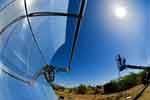A mirror alignment measurement device, invented by Rich Diver, a researcher at Sandia National Laboratories, may soon make one of the most popular solar collector systems, parabolic troughs, more affordable and energy efficient.
Diver’s new theoretical overlay photographic (TOP) technique could cure a significant problem with trough systems - inaccurate mirror alignment that prevents sunlight from precisely focusing on solar receivers.
‘Improperly aligned mirrors result in lost and wasted energy,’ Diver said.
Parabolic troughs themselves use mirrored surfaces curved in a parabolic shape. The mirrors focus sunlight on a receiver tube running the length of the trough. Oil runs through the focal region where it is heated to high temperatures and then goes through a heat exchanger to generate steam. The steam is then used to run a power plant.
Diver's alignment technique involves overlaying theoretical images that represent the optimal position of the heat collection element in the mirrors onto photographic images taken by digital cameras of the actual mirrors, and then adjusting the alignment of the mirrors until they match.

Sandia researcher Rich Diver sets up a device he has developed to calibrate trough-type solar dish collectors to maximize the amount of sunlight they capture.
‘This whole process is very simple,’ Diver said. ‘Once the mirrors are aligned, the energy savings start. It’s like picking money off the ground. And the mirrors are aligned for the life of the plant.’




Swiss geoengineering start-up targets methane removal
No mention whatsoever about the effect of increased methane levels/iron chloride in the ocean on the pH and chemical properties of the ocean - are we...